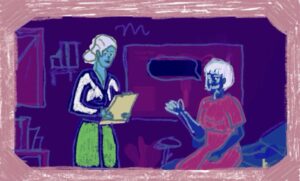
Camila Hernandez
Two weeks ago, Peter and Susan Cooper donated $50 million to Georgetown’s Athletic Department—while construction for the $62 million John R. Thompson Jr. Intercollegiate Athletics Center is well underway. These recent donations made to the Athletics Department have highlighted how neglected the arts scene is by administrators and alumni alike. While such donations are certainly a positive for Georgetown, the university should also increase its efforts to court funds—whether from generous single gifts or fundraising campaigns—for the arts on campus.
Sports obviously are a huge part of the college experience, offering students the opportunity to challenge themselves and cheer for their community. This Editorial Board certainly recognizes the benefits of a thriving athletics scene on the Hilltop. But it is hard to sit by and watch as one portion of the student body stands to benefit so much from the generosity of alumni and parents, while many others will not. Recently, the de la Cruz family donated an undisclosed amount to finance an art gallery in their name in the Walsh Building. However, more is needed for the art community, where student clubs and faculty departments continue to be constrained by insufficient resources.
For the Department of Art, the studios on floors two and three of the Walsh building are notoriously cramped, as courses and other departments compete for square footage. Storage space is severely lacking. Art students often vie for locker space, leaving many with no choice but to schlep their supplies to and from class. Space for full-size projects (which could be anything from paintings to sculptures) is virtually non-existent, forcing students to leave in-progress works out in the open—a considerable risk.
What’s more, prospective art students face a studio fee to the tune of $150 per semester. Students also must purchase their own materials for class, an out-of-pocket expense that can cost over $200. These expenses prohibit some students from taking art courses at Georgetown. Solutions could involve providing the Art Department with funds to purchase supplies to distribute to students, allowing Hoyas of all backgrounds and interests to try their hand at art.
Students involved with Georgetown’s theatre and music scene face challenges as well. Even with the opening of Healy Family Student Center, spaces to practice music and acting are difficult to come by and some in poor condition. Georgetown’s Children’s Theatre practices in the Village C classroom, a facility with restricted GOCard access that’s adjacent to the GERMS office, resulting in frequent lock-outs and noise. In New North’s Studio D, students may practice and record music, but approval is needed from the Department of Performing Arts, a process that can be more accessible to performing arts student than to those within other departments.
The new de la Cruz Gallery of Art will replace Walsh’s Black Box theater, eliminating a major performance space on campus—one the Nomadic Theatre typically uses for its performances. So, whatever benefits for the Department of Art and Art History will see are coming at the expense of the Department of Performing Arts.
Student-run arts groups face particular challenges, as they receive funding from the Performing Arts Advisory Council, an advisory board comprised of both students and faculty. Other advisory boards, like the Student Activities Commission (SAC), are entirely student-run . As a result, the Department of Performing Arts holds a tighter grip on the groups it funds, resulting in more oversight than student groups who receive SAC funding.
We do not have the space here to address all the shortcomings that the Georgetown art community faces. In general, resources and space remain inadequate, reducing the visibility and accessibility of arts on campus. It suffices to say that more financing is needed. To cultivate a thriving arts community, the university should allocate additional funds from the successful “Campaign for Georgetown” and encourage well-off alumni to follow suit.







I have had this discussion with so many people on this campus. So so many people feel this way, but they’re not seen as the typical Georgetown perspective. Thanks for writing this.
It’s not exactly a surprise that sports are more popular than the arts from a spectator, participation, revenue-generation, and philanthropy standpoint. That’s probably true at 99.9% of colleges in America. Whether you agree with that preference or not, it is a clearly and widely demonstrated one and has to be recognized. You can’t force people to care more about one extracurricular activity over another one, and you’re especially unlikely to succeed in shaming them into it.
Having said all that, it’s indisputable that a great deal more could be done to provide adequate – not luxury, but just even adequate – facilities for both academic and extracurricular arts activities. To accomplish this requires a strong vision that can be communicated as a priority to the broader University community, especially the alumni base. We’ve seen some progress in this field before: the Davis Performing Arts Center is a fine facility that was entirely funded through philanthropy; the dance studios in the Healy Family Student Center seem to be in high demand; and the aforementioned de la Cruz family gift. To repeat and expand on these successes, it is necessary for arts advocates among the faculty, administration, student body, and alumni to come together and help create that shared vision that can be put forward and ultimately realized.
Accomplishing this requires leadership, however. Sitting back and waiting for someone else to do it, or writing one-off editorials (complete with gratuitous and unnecessary use of scare quotes around ‘Sports’ in the accompanying cartoon – what is even the point of that?) and then moving on to the next topic, will not do anything. The various athletics communities have had plenty of leaderships pushing over many years to their gains happen. Who are the arts leaders? Stand up and do for self.